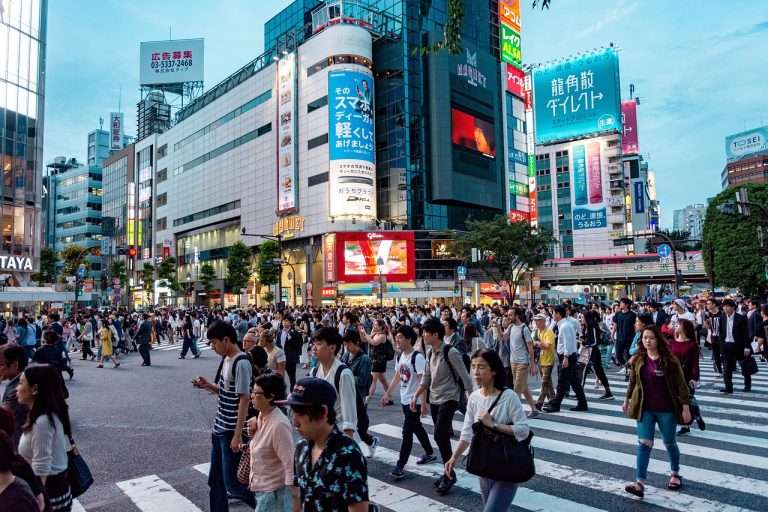Tokyo, Japan, is a city of remarkable contrasts, where tradition seamlessly blends with modernity. Visiting Tokyo in different seasons offers a unique and diverse experience each time. From the cherry blossoms of spring to the vibrant festivals of summer, the colorful foliage of autumn, and the serene snowscapes of winter, Tokyo beckons travelers all year round. In this article, we’ll explore what makes each season in Tokyo special and what you can expect when you visit during different times of the year.
Spring: Cherry Blossom Extravaganza (March to May)
Spring in Tokyo is a season of enchantment and renewal. It’s the time when cherry blossoms, known as “sakura,” grace the city with their ephemeral beauty, turning Tokyo into a picturesque wonderland. The cherry blossom season typically begins in late March and extends into early May, although the exact timing can vary from year to year depending on the weather conditions. This article will delve deeper into this magical season, exploring the significance of cherry blossoms in Japanese culture and providing an in-depth look at some must-visit spots to experience the Cherry Blossom Extravaganza in Tokyo.
The Significance of Cherry Blossoms in Japanese Culture
Before we explore the specific spots to visit during the cherry blossom season in Tokyo, it’s essential to understand the profound cultural significance that sakura holds in Japanese society. The cherry blossom, with its delicate petals and fleeting existence, symbolizes the transient nature of life, making it a powerful and poignant metaphor. The concept of “mono no aware” encapsulates this idea—the appreciation of the impermanence of things.
During the sakura season, Japan experiences “hanami,” a centuries-old tradition where people gather to view and celebrate the cherry blossoms. Hanami involves picnicking beneath the sakura trees, enjoying food and drinks with friends and family, and reveling in the beauty of the blossoms. It’s a time of reflection and appreciation for the beauty of nature and life’s fleeting moments.
Must-Visit Spots During the Cherry Blossom Season
- Ueno Park: Ueno Park is undoubtedly one of the most iconic and beloved locations to view cherry blossoms in Tokyo. The park, originally established in 1873, boasts over a thousand cherry trees of various varieties, making it a sea of pink and white blossoms during spring. When the cherry blossoms are in full bloom, Ueno Park comes alive with a festive atmosphere. Locals and tourists alike gather here for hanami parties, filling the park with the sweet scent of cherry blossoms and the sounds of laughter and celebration.Ueno Park is not just about cherry blossoms; it also houses several museums, including the Tokyo National Museum and the Tokyo Metropolitan Art Museum. So, you can combine your love for art and culture with your admiration for sakura.
- Chidorigafuchi Moat: Imagine strolling along a tranquil moat surrounding the Imperial Palace, with cherry trees gracefully arching over the water, their blossoms casting gentle reflections. That’s the experience you’ll have at Chidorigafuchi Moat during the cherry blossom season. The sight of cherry blossoms framing the iconic Imperial Palace is nothing short of mesmerizing.For a particularly enchanting experience, visit Chidorigafuchi in the evening when the blossoms are illuminated. The soft, ethereal glow adds a touch of magic to the scene and creates a romantic ambiance that’s perfect for couples or anyone seeking a serene escape from the bustling city.
- Sumida Park: For a more relaxed and leisurely cherry blossom viewing experience, Sumida Park along the Sumida River is an excellent choice. The park’s picturesque setting, with cherry trees lining the riverbanks, offers a peaceful escape from the urban hustle and bustle. As you stroll along the river, you’ll be surrounded by the delicate pink and white blossoms, creating a sense of serenity and harmony with nature.To elevate your experience, consider taking a cruise on the Sumida River. Many companies offer boat rides specifically during the cherry blossom season, allowing you to enjoy Tokyo’s skyline as it shimmers against the backdrop of sakura. It’s a unique and unforgettable way to immerse yourself in the beauty of spring in Tokyo.
Cherry Blossom Season Tips
- Check the Blossom Forecast: The timing of cherry blossom season can vary each year, so it’s essential to monitor the “sakura zensen” (cherry blossom front) forecast, which predicts when the blossoms will reach full bloom in different regions of Japan, including Tokyo. This information will help you plan your trip to coincide with the peak bloom.
- Pack a Picnic: One of the most cherished aspects of hanami is the picnic beneath the cherry trees. Pack a bento box filled with delicious Japanese snacks, sushi, or seasonal treats, and don’t forget a bottle of sake or tea to toast to the beauty of the blossoms.
- Respect the Environment: While enjoying hanami, remember to be respectful of the natural surroundings. Dispose of your trash properly and avoid damaging the cherry trees or plucking the blossoms. Hanami is a time to celebrate the harmony between nature and people.
- Enjoy Festive Activities: Many parks and locations with cherry blossoms offer additional attractions during the season, such as food stalls, traditional performances, and cultural exhibitions. Embrace the festive atmosphere and explore these offerings to enhance your experience.
In conclusion, spring in Tokyo is a time when the city dons its most enchanting attire. The Cherry Blossom Extravaganza, with its cultural significance and breathtaking beauty, is a season that beckons travelers from around the world. Whether you choose to revel in the vibrant atmosphere of Ueno Park, take a romantic evening stroll along Chidorigafuchi Moat, or cruise the Sumida River under a canopy of sakura, your springtime visit to Tokyo will undoubtedly be a memory you’ll cherish for a lifetime.
Summer: Festivals and Fireworks (June to August)
Summer in Tokyo is a season that pulses with vibrant energy and excitement, despite the scorching heat and high humidity. The Japanese summer is a time for festivals, fireworks, and a rich cultural experience that showcases the lively spirit of the city. In this section, we will delve into the heart of Tokyo’s summer season, exploring two major events—the Asakusa Samba Carnival and the Sumidagawa Fireworks Festival—and also consider the refreshing escape offered by the nearby beaches.
Summer in Tokyo: A Season of Contrasts
Summer in Tokyo typically spans from June to August and brings with it hot and humid weather. Daily temperatures can soar into the 30s°C (80s and 90s°F), making it essential to stay hydrated and take precautions against heat-related illnesses. However, the summer season is far from oppressive; it’s a time of vibrant festivals and exciting outdoor activities that make the most of the warm weather.
Asakusa Samba Carnival: A Colorful Extravaganza
One of the most anticipated events of the Tokyo summer calendar is the Asakusa Samba Carnival. This lively and colorful parade, held annually in late August, is a captivating blend of Brazilian carnival traditions and Japanese festival culture. Here’s why it’s a must-see:
1. Samba Dancers and Vibrant Costumes: The Asakusa Samba Carnival showcases samba dance troupes from both Japan and Brazil, bedecked in extravagant and colorful costumes. The performers exude energy and enthusiasm as they dance to the infectious rhythms of samba music. Their vibrant attire and graceful moves create a feast for the eyes and a burst of energy in the heart of Tokyo.
2. Infectious Party Atmosphere: The carnival atmosphere at Asakusa is contagious. The streets come alive with not only samba dancers but also spectators who join in the revelry. Expect to see people wearing festive attire, painting their faces, and dancing in the streets. Food stalls offering delicious Brazilian and Japanese street food add to the party spirit.
3. Traditional Meets Modern: The Asakusa Samba Carnival takes place in the historic district of Asakusa, known for its iconic Senso-ji Temple and Nakamise Shopping Street. This juxtaposition of modern carnival revelry against the backdrop of traditional Japanese culture adds a unique and fascinating layer to the event.
Sumidagawa Fireworks Festival: A Sky Ablaze
For a dazzling display of pyrotechnic artistry, the Sumidagawa Fireworks Festival is an annual highlight of Tokyo’s summer season. Held in late July, this grand event lights up the night sky over the Sumida River with a breathtaking array of fireworks. Here’s what you can expect:
1. Awe-Inspiring Fireworks: The Sumidagawa Fireworks Festival is renowned for its spectacular fireworks that burst in an array of colors and intricate patterns. The sheer scale and precision of the display leave spectators in awe. It’s a true visual feast that paints the Tokyo skyline with vibrant hues.
2. Riverside Viewing: To fully appreciate the grandeur of the fireworks, finding the perfect viewing spot along the Sumida River is crucial. Locals and visitors alike flock to parks, riverbanks, and bridges to secure their vantage point. Arriving early and setting up a picnic is a common practice, and the atmosphere is both festive and communal.
3. Food and Entertainment: Food stalls, known as “yatai,” line the streets near the festival grounds, offering a wide variety of Japanese street foods and snacks. You can savor festival favorites like takoyaki (octopus balls), yakitori (grilled chicken skewers), and kakigori (shaved ice). Additionally, cultural performances and live music add to the entertainment value of the event.
Beaches: A Seaside Escape from the City Heat
While Tokyo’s summer festivals and fireworks offer excitement and cultural immersion, the sweltering heat can be challenging to endure. To escape the city heat, many Tokyoites and visitors take day trips to nearby beaches. Two popular beach destinations near Tokyo are Enoshima and Kamakura:
1. Enoshima: Located less than an hour by train from Tokyo, Enoshima is a picturesque island that offers a delightful coastal retreat. Besides enjoying the sandy beaches, visitors can explore Enoshima’s enchanting shrines, caves, and gardens. The island is also known for its fresh seafood, and you can savor grilled fish and other local delicacies at beachside restaurants.
2. Kamakura: Another easily accessible destination, Kamakura, is known for its historical significance and beautiful coastline. Kamakura Beach is a popular spot for swimming and sunbathing. While you’re in the area, don’t miss the chance to visit the Great Buddha (Daibutsu), Hase-dera Temple, and the serene Zeniarai Benten Shrine.
Tips for Enjoying Tokyo’s Summer Season
- Stay Hydrated: Given the intense heat and humidity, it’s essential to drink plenty of water to stay hydrated. You’ll find vending machines throughout the city selling a variety of beverages, including refreshing cold tea and sports drinks.
- Wear Light and Breathable Clothing: Opt for lightweight and breathable clothing to stay comfortable in the summer heat. Don’t forget sunscreen, a hat, and sunglasses to protect yourself from the sun.
- Plan Ahead: For both the Asakusa Samba Carnival and the Sumidagawa Fireworks Festival, it’s advisable to plan your transportation and arrival time well in advance, as these events can get crowded. Arriving early ensures you get a good spot.
- Respect Local Customs: While enjoying festivals and beaches, be mindful of local customs and etiquette. Dispose of your trash responsibly, and follow any rules or guidelines set by event organizers.
In conclusion, summer in Tokyo is a dynamic and exhilarating season filled with festivals, fireworks, and beach getaways. Despite the sweltering heat, the city comes alive with a vibrant energy that is uniquely Tokyo. Whether you’re dancing in the streets at the Asakusa Samba Carnival, gazing in awe at the Sumidagawa Fireworks Festival, or seeking respite on the sandy shores of Enoshima or Kamakura, Tokyo’s summer season offers an array of experiences that are sure to create lasting memories.
Autumn: Foliage and Tranquility (September to November)
Autumn in Tokyo is a season of enchantment and transformation. As the stifling heat of summer gives way to milder temperatures, the city undergoes a breathtaking metamorphosis. The lush greenery of summer fades into a vibrant tapestry of red, orange, and yellow leaves, turning Tokyo’s parks and gardens into veritable wonderlands. In this section, we’ll take an in-depth look at Tokyo’s autumn season, exploring the profound beauty of fall foliage and the tranquility it brings to the city. We’ll also highlight three exceptional locations that epitomize the essence of autumn in Tokyo: Meiji Jingu Gaien, Koishikawa Korakuen Garden, and Mount Takao.
The Splendor of Autumn Foliage in Tokyo
Autumn in Tokyo is a season of contrasts. The summer humidity gradually dissipates, leaving behind cooler, crisp air that makes outdoor exploration a pleasure. It’s during this time that the city’s trees, predominantly ginkgo, maple, and zelkova, don their autumnal attire. As the leaves change color, Tokyo becomes a canvas of reds, oranges, and yellows, drawing photographers, nature enthusiasts, and locals alike to bask in its splendor.
Meiji Jingu Gaien: A Tunnel of Red and Gold
One of Tokyo’s most famous spots for autumn foliage is the Meiji Jingu Gaien, an avenue of trees located near the iconic Meiji Shrine. This remarkable stretch of greenery transforms into a breathtaking tunnel of red and gold leaves during the autumn season. Here’s what makes it a must-visit destination:
1. Iconic Location: Meiji Jingu Gaien is not just a haven for autumn enthusiasts; it’s also home to some of Tokyo’s most significant cultural landmarks. The nearby Meiji Shrine, surrounded by a lush forest, offers a serene contrast to the bustling city, making it an ideal place for a peaceful stroll before or after admiring the foliage.
2. Metasequoia Trees: The Metasequoia trees that line the avenue of Meiji Jingu Gaien are the stars of the show during autumn. These towering trees, with their feathery leaves, turn vibrant shades of red and gold, creating a mesmerizing canopy overhead. Walking beneath these trees feels like stepping into a different world—a world painted in warm, autumnal hues.
3. Sporting Events and Activities: The avenue is also home to sports facilities, including a stadium and tennis courts. During autumn, it hosts various sporting events and activities, so you can combine your love for autumn foliage with your passion for sports.
Koishikawa Korakuen Garden: A Timeless Oasis
Koishikawa Korakuen Garden, one of Tokyo’s oldest and most beautiful gardens, is a perfect oasis of tranquility amidst the bustling city. Nestled in the Bunkyo ward, this meticulously designed landscape is a testament to Japan’s appreciation for the changing seasons. Here’s what makes it a must-visit destination in autumn:
1. Stunning Landscapes: Koishikawa Korakuen is renowned for its exquisite landscapes that seamlessly blend natural beauty with traditional Japanese garden design principles. In autumn, the garden becomes a visual masterpiece, with carefully placed trees and ponds reflecting the fiery hues of the season.
2. Thematic Gardens: The garden is divided into different sections, each with its own unique charm. The Momijiyama (Maple Mountain) area, in particular, comes alive with vibrant maple leaves during autumn. The Momiji-en (Maple Garden) features a serene pond surrounded by fiery foliage, making it an ideal spot for contemplation.
3. Teahouse Experience: Enjoy matcha tea and traditional Japanese sweets at the Engetsu-kan Teahouse, which offers a tranquil setting with views of the garden’s exquisite scenery. It’s a wonderful way to immerse yourself in Japanese culture while appreciating the beauty of autumn.
Mount Takao: A Day Trip into Nature antabuse avec ou sans ordonnance
For those seeking a more immersive experience in nature, a day trip to Mount Takao is a perfect choice. Located just outside Tokyo, this picturesque mountain offers hiking trails through lush forests, with autumn foliage as the crowning jewel. Here’s what you can expect:
1. Scenic Hiking Trails: Mount Takao boasts a range of hiking trails suitable for various fitness levels. Whether you’re a seasoned hiker or a casual nature enthusiast, you’ll find a trail that suits your preferences. The trails wind through dense forests, past serene temples, and up to the summit, where a panoramic view of Tokyo awaits.
2. Autumn Flora: As you ascend Mount Takao, you’ll be surrounded by a tapestry of autumn colors. The mix of deciduous trees, such as maple and oak, creates a vibrant contrast with the evergreen conifers. The sight of crimson and gold leaves against the backdrop of Tokyo’s skyline is a sight to behold.
3. Cultural Attractions: Mount Takao is home to several temples and shrines, including the Yakuoin Temple, which is a popular pilgrimage site. The temple grounds offer a serene escape and provide insight into Japan’s spiritual traditions.
Tips for Enjoying Autumn in Tokyo
- Timing is Key: The timing of the autumn foliage season can vary from year to year, so it’s essential to monitor the foliage forecast, known as “koyo,” to plan your visit during peak colors.
- Weekday Visits: Popular spots like Meiji Jingu Gaien and Koishikawa Korakuen Garden can get crowded on weekends. Consider visiting during weekdays for a more peaceful experience.
- Comfortable Footwear: If you plan to hike Mount Takao or explore any natural areas, wear comfortable and sturdy footwear suitable for walking on uneven terrain.
- Photography: Don’t forget your camera or smartphone to capture the breathtaking beauty of the autumn foliage. Early morning or late afternoon light can enhance the colors and textures.
In conclusion, autumn in Tokyo is a time of profound beauty and tranquility. As the city’s parks and gardens transform into kaleidoscopes of red, orange, and yellow leaves, Tokyoites and visitors alike take solace in the serene charm of the season. Whether you choose to stroll through the breathtaking tunnel of Meiji Jingu Gaien, immerse yourself in the timeless oasis of Koishikawa Korakuen Garden, or embark on a nature-filled adventure on Mount Takao, autumn in Tokyo promises an unforgettable experience that celebrates the vibrant hues of the season and the cultural appreciation for its fleeting beauty.
Winter: Snowy Serenity (December to February)
Winter in Tokyo ushers in a season of serene beauty and tranquil charm. While the city may not be buried under meters of snow, occasional snowfall graces the streets, parks, and rooftops, turning Tokyo into a serene wonderland. The atmosphere takes on a quieter and more contemplative tone, making it an ideal time for visitors seeking a different side of Tokyo’s character. In this section, we’ll delve into the unique aspects of Tokyo’s winter season, including the mesmerizing illumination displays, the cozy retreats offered by nearby hot springs (onsen), and the cultural richness of traditional winter festivals.
Illumination Displays: Tokyo’s Winter Wonderland
One of the most enchanting features of winter in Tokyo is the transformation of the city into a dazzling wonderland of lights and colors. Illumination displays, known as “illumiyata” in Japanese, adorn the streets, parks, and landmarks, creating a magical ambiance that captivates both residents and visitors. Here are some notable spots to experience Tokyo’s illuminations:
1. Tokyo Midtown: Located in the upscale Roppongi district, Tokyo Midtown is renowned for its spectacular winter illuminations. The Midtown Garden dazzles with millions of LED lights, forming intricate displays and immersive light tunnels. The illumination event often has a theme, and past themes have included cherry blossoms in winter and art-inspired displays.
2. Roppongi Hills: Another Roppongi gem, Roppongi Hills, hosts its own impressive illumination event. The Mori Garden becomes a mesmerizing landscape of lights, often featuring unique art installations. The Tokyo City View observation deck provides a breathtaking view of the illuminated city skyline.
3. Caretta Shiodome: The Caretta Shiodome building in the Minato ward is famous for its artistic illumination displays. The annual “White Xmas in the Sea” illumination event transforms the entire complex into a winter wonderland, complete with music and light shows.
4. Yebisu Garden Place: Yebisu Garden Place, situated near Ebisu Station, offers a stunning illumination display during the winter season. The centerpiece is the Yebisu Garden Place Clock Tower, which is adorned with thousands of sparkling lights.
Hot Springs (Onsen): Winter’s Cozy Retreat
As the temperature drops and Tokyoites seek warmth and relaxation, hot springs, or “onsen,” become an inviting escape. While Tokyo itself doesn’t have natural hot springs, several nearby destinations offer the perfect opportunity to soak in warm, mineral-rich waters while surrounded by beautiful winter landscapes. Two popular onsen destinations near Tokyo are Hakone and Nikko:
1. Hakone: Just a short train ride from Tokyo, Hakone is a renowned onsen town set against the backdrop of the majestic Hakone Mountains. The region boasts numerous traditional ryokan (Japanese inns) with private hot spring baths, as well as public onsen facilities where you can enjoy the cozy warmth and serene views of snow-capped mountains. Don’t miss a relaxing soak while gazing at Mount Fuji if the weather is clear.
2. Nikko: Nikko, located to the north of Tokyo, is not only famous for its UNESCO World Heritage Sites but also for its therapeutic hot springs. Nikko’s onsens offer a rustic and traditional atmosphere, allowing you to immerse yourself in Japanese culture while indulging in the soothing waters. The scenic beauty of Nikko, especially during winter, adds to the charm of the experience.
Winter Festivals: Embracing Tradition
Tokyo’s winter season also brings forth traditional festivals that offer a glimpse into Japanese culture and heritage. Here are two notable winter festivals to experience:
1. Oshogatsu (New Year) Celebrations: The Japanese New Year, known as Oshogatsu, is a time of deep cultural significance. It marks the beginning of the year with various customs and traditions. Tokyoites celebrate by visiting temples and shrines for Hatsumode (the first shrine visit of the year) and enjoying traditional foods like mochi (rice cakes) and ozoni (a special soup). The city is adorned with elaborate decorations, including kadomatsu (bamboo and pine decorations) and shimekazari (decorative ropes), adding to the festive atmosphere.
2. Setsubun Bean-Throwing Ceremony: Setsubun is a traditional Japanese festival that takes place in early February. It is celebrated to drive away evil spirits and welcome good fortune. One of the most entertaining aspects of Setsubun is the bean-throwing ceremony, known as “mamemaki.” At various temples and shrines across Tokyo, visitors can participate by throwing roasted soybeans while shouting “Oni wa soto, fuku wa uchi” (Out with the demons, in with good luck). It’s a fun and lively event that both children and adults enjoy.
Tips for Enjoying Winter in Tokyo
- Dress Warmly: While Tokyo doesn’t experience extreme cold, it’s advisable to dress in layers during the winter months to stay comfortable, especially when exploring outdoor illumination displays.
- Check Event Schedules: Be sure to check the schedules for illumination events and winter festivals, as dates and themes may vary from year to year.
- Reserve Accommodations Early: If you plan to visit nearby onsen towns like Hakone or Nikko during the winter season, consider booking accommodations well in advance, as these areas can get crowded during this time.
- Sample Seasonal Delicacies: Winter is an excellent time to savor seasonal Japanese dishes such as nabe (hot pot), oden (a hot, simmered dish), and yudofu (tofu hot pot).
In conclusion, winter in Tokyo unveils a different facet of the city’s charm—a serene and quieter side that allows visitors to immerse themselves in magical illumination displays, relax in cozy hot springs, and partake in traditional festivals that honor Japan’s rich cultural heritage. Whether you’re wandering through Tokyo’s illuminated streets, enjoying a soak in an onsen, or taking part in Setsubun festivities, Tokyo’s winter season offers an enchanting and culturally rich experience that’s bound to create lasting memories.
In Summary
Tokyo, Japan, offers a year-round adventure for travelers seeking to explore its diverse seasons. Whether you’re captivated by the cherry blossoms of spring, the festive spirit of summer, the autumnal beauty, or the serene snowscapes of winter, Tokyo has something special to offer in every season. So, plan your trip accordingly and immerse yourself in the unique charm of Tokyo, no matter when you choose to visit.






